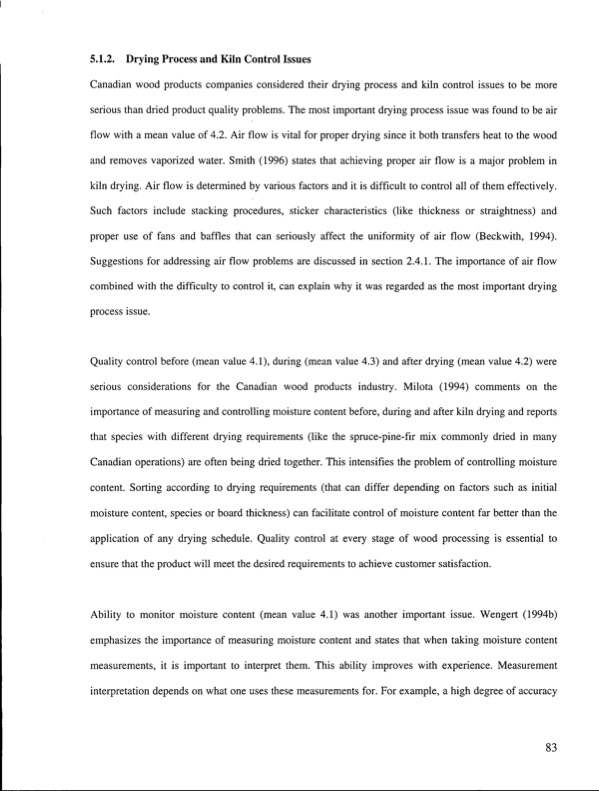
PDF Publication Title:
Text from PDF Page: 092
5.1.2. Drying Process and Kiln Control Issues Canadian wood products companies considered their drying process and kiln control issues to be more serious than dried product quality problems. The most important drying process issue was found to be air flow with a mean value of 4.2. Air flow is vital for proper drying since it both transfers heat to the wood and removes vaporized water. Smith (1996) states that achieving proper air flow is a major problem in kiln drying. Air flow is determined by various factors and it is difficult to control all of them effectively. Such factors include stacking procedures, sticker characteristics (like thickness or straightness) and proper use of fans and baffles that can seriously affect the uniformity of air flow (Beckwith, 1994). Suggestions for addressing air flow problems are discussed in section 2.4.1. The importance of air flow combined with the difficulty to control it, can explain why it was regarded as the most important drying process issue. Quality control before (mean value 4.1), during (mean value 4.3) and after drying (mean value 4.2) were serious considerations for the Canadian wood products industry. Milota (1994) comments on the importance of measuring and controlling moisture content before, during and after kiln drying and reports that species with different drying requirements (like the spruce-pine-fir mix commonly dried in many Canadian operations) are often being dried together. This intensifies the problem of controlling moisture content. Sorting according to drying requirements (that can differ depending on factors such as initial moisture content, species or board thickness) can facilitate control of moisture content far better than the application of any drying schedule. Quality control at every stage of wood processing is essential to ensure that the product will meet the desired requirements to achieve customer satisfaction. Ability to monitor moisture content (mean value 4.1) was another important issue. Wengert (1994b) emphasizes the importance of measuring moisture content and states that when taking moisture content measurements, it is important to interpret them. This ability improves with experience. Measurement interpretation depends on what one uses these measurements for. For example, a high degree of accuracy 83PDF Image | KILN DRYING PROBLEMS AND ISSUES IN CANADA

PDF Search Title:
KILN DRYING PROBLEMS AND ISSUES IN CANADAOriginal File Name Searched:
ubc_2004-0049.pdfDIY PDF Search: Google It | Yahoo | Bing
5,000 BF Shipping Container Lumber Dry Kiln For Quality Lumber The 5,000 BF container kiln consists of one 40 foot high-cube aluminum shipping container... More Info
Shipping Container Lumber Dry Kilns by Global Energy Global Energy designed and developed the container kiln back in 1991. The purpose is to give access to portable sawmill owners, furniture makers, and small business the value added profit of dry kiln lumber and quality hardwoods... More Info
Vacuum Kiln Conversion Kit for Lumber and Wood Dry Kilns Convert your existing conventional dry kiln into a fast drying vacuum kiln. Similar to vacuum bagging in the boat building and aircraft industry, we have come up with a proprietary process which allows you to build a very simple vacuum kiln at a fraction of the price, and without the intensive conventional metal chamber structure... More Info
Vacuum Pump Cart System for Bagging Clamping Wood Drying and more Vacuum Cart with 2HP Pump and Dual Pistons with multiple multiplex vacuum ports and liquid reservoir... More Info
Vacuum Bagging Basics Vacuum bagging is a method of clamping, which has traditionally been used in the composites industry, but can also be used for vacuum drying materials, including wood products... More Info
| CONTACT TEL: 608-238-6001 Email: greg@globalmicroturbine.com | RSS | AMP |